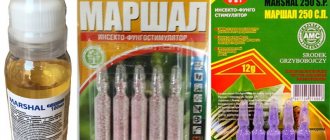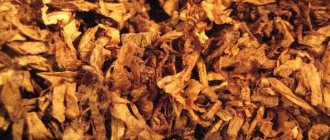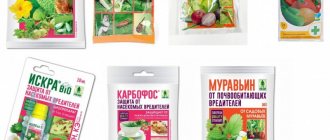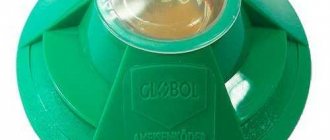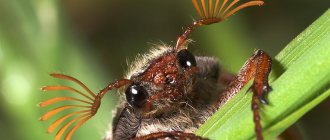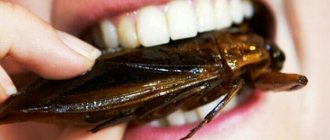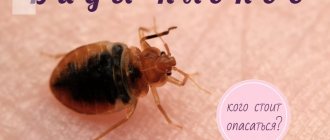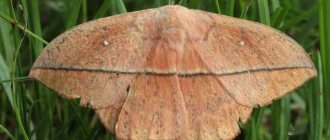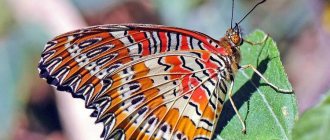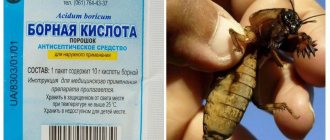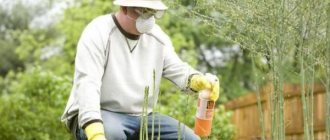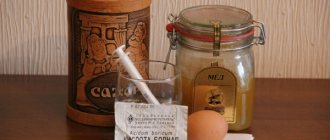The plant foods that people grow in their gardens and gardens for themselves are also consumed by huge families of harmful insects. They spoil and destroy harvests of vegetables and fruits and destroy plants. If it is not possible to scare away parasitic creatures from the territory of cultivated plants and the animal world using folk and biological methods, then gardeners are forced to use chemicals.
Nowadays, the danger of some chemicals for plants and people has decreased, since manufacturers produce biogenic agents that are analogues of natural pheromones and growth regulators. They prevent parasitic insects from reproducing. In our article we will tell you what groups and classes dangerous insecticides are classified into, and we will give a list of drugs for annoying pests on plants and fruits.
Characteristic
Preparations responsible for killing insects belong to the group of insecticides. Available in the form of powders, sprays, aerosols, granules, gels. The products are used outdoors and indoors and are classified according to a number of parameters.
Even in ancient times, to protect plantings from pests, plants were treated with infusions and extracts of poisonous herbs, and certain chemical compounds were used to get rid of parasites. Arsenic, mercury, sulfur, and later kerosene were used by farmers in different countries. Already in the 20th century, chlorine-containing (“DDT”), organophosphorus (OP) compounds, as well as synthetic pyrethroids appeared.
Nowadays, the main emphasis is on the production of analogues of natural components, so-called biological pesticides. They are considered effective and at the same time less dangerous from an environmental point of view.
Serious research is being conducted in the production of biologically active compounds, thanks to which it is possible to regulate the growth and development of harmful insects (pheromones, antifeedants, attractants).
Thunder
Thunder, G, 3%, granules. The active principle is diazonin. Manufactured /Moscow/ using Swiss technology. Recommended by the company for combating mole crickets on vegetable and flower crops, strawberries and potatoes. Potato, or Nightshade (from the Latin Solánum tuberósum), is a type of perennial to..., as well as for combating ants.
To combat the mole cricket, 2-3 g of granules (1 teaspoon) are placed in the mole cricket's burrows and passages to a depth of 3-5 cm and with a distance between granules of 0.5-0.7 m. After laying the granules, the soil is slightly compacted, the dry soil is moistened . Granules are applied 5-10 days before sowing seeds or planting, and again, if necessary, in places where mole crickets accumulate. The period of protective action is 10-14 days.
In the fight against ants, first remove the top layer of soil (2-3 cm) from the anthill, then scatter 1-3 g (0.5-1 teaspoon) of granules evenly over the surface. The place where the granules are applied is sprinkled with earth or covered with roofing felt, plywood, etc. The ants disappear on the 2-4th day after applying the drug. The duration of action of the drug is 2-3 months.
Classification, application features
The group of insecticidal products includes hundreds of items. For convenience, it is customary to combine drugs according to a number of criteria:
- production classification (against which pests);
- chemical separation (by composition);
- by nature, mechanism of action, as well as methods of penetration of the poison into the body;
- according to the place of application (for plants, for premises).
The tables present in detail the classification according to the main parameters.
By purpose of use
| Group | An object |
| Acaricides | Ticks |
| Aficides | Aphids |
| Attractants (including pheromones) | Luring into traps |
| Ovicides | Pest eggs |
| Larvicides | Larvae |
| Insecticides | Insects of different types |
| Repellents | Repellent |
| Antifeedants | Disruption of insect feeding processes |
On a note! Many products used in agriculture are combined, for example, they are both ovicides and insectoacaricides.
By chemical composition
| Group | Active substance | Peculiarities |
| Pyrethroids/pyrethrins | Permethrin, cypermethrin, allethrin and others | Prolonged use causes resistance |
| Organophosphorus (FOS) | Malathion, diazinon, dichlorvos, fozalon, chlorophos | Systemic action. Effective against arthropod pests |
| Organochlorines (OCs) | DDT, hexachlorane | Production is currently closed |
| Neurotoxins | Bensultap | Extracted from the tissues of marine organisms |
| Carbamates | Methomyl, carbofuran | Highly toxic, are the basis of many fungicides and herbicides |
| Bacterial preparations | Bacillus thuringiensis, polypeptide | There is no phytotoxicity or resistance. Belongs to new generation products |
| Avermectins | Avertin N, abamectin | Unstable connections, work well at high temperatures |
| ISH (chitin synthesis inhibitors) | Cyromazine, lufenuron | They are distinguished by selectivity of action, efficiency, speed |
| Neonicotinoids | Thiacloprid, imidacloprid, acetamiprid | One of the main groups of insecticides, means of systemic action. Not phytotoxic |
| Herbal preparations | Nicotine | |
| Juvenoids | Fenoxycarb, pyriproxyfen | Affect molting processes |
By mechanism of action
| An object | Groups |
| Chitin synthesis inhibitors | Benzoylurea |
| Disabling the nervous system | Carbamates, pyrethroids |
| Receptor blocking | Avermectins, bensultap, neonicotinoids |
According to the method of penetration of pests into the body
| Name | Way |
| Intestinal | With food |
| Contact | When any part of an insect comes into contact with poison |
| System | Penetration into plants, movement through tissues, then death of pests (by eating treated leaves, roots, shoots, buds) |
| Fumigants | Through the respiratory organs |
Application options
| Way | Preparative form |
| Fumigation (spraying) | Aerosols |
| Processing of seed and planting material (spraying, soaking) | Powders, concentrates, emulsions |
| Pollination (dusting) | Powders |
| Application to the soil | Powders, liquid, granules |
| Spraying | Working solutions based on powders, emulsions, concentrates |
| Barrier agent | Gels, crayons |
| Traps | Granules, powder (bait) |
Bankol
Bankol, 50% SP. Used against the Colorado potato beetle on potatoes. Potato, or tuberous nightshade (from the Latin Solánum tuberósum), is a type of perennial plant... by spraying plants with a solution: 4-6 g per 10 liters of water. Spraying time: immediately after appearance on potatoes Potato, or Nightshade (from the Latin Solánum tuberósum), is a type of perennial beetle that has overwintered, when larvae appear in spring, in summer against beetles and larvae of a new generation. Treatment with the drug can be carried out no more than two times. The last treatment is no later than 20 days before harvesting. A solution of the drug of the same strength as for potatoes Potatoes, or Nightshade (from the Latin Solánum tuberósum), is a type of perennial to..., peppers, tomatoes, eggplants are sprayed against the Colorado potato beetle, gnawing caterpillars and cotton bollworm. The maximum number of sprayers is two, the last one is 40 days before the start of the first harvest.
Effective drugs
Modern manufacturers produce dozens of insecticides, and the gardener’s task is to choose the most suitable ones, based on specific requests and conditions. Judging by the reviews, products produced by Green Belt, Green Gardener's Pharmacy, and Bayer are popular.
Insecticides for the garden and garden
| Name | Against what pests | Release form | Features of application |
| Avermectins | |||
| "Kleschevit" | Ticks | Liquid | Waiting period - 3 days |
| "Fitoverm", enteric contact | White moths, cutworms, cabbage moths, aphids, spider mites | Emulsion concentrate | Insectoacaricidal drug. Does not accumulate in plants, fruits, vegetables. Efficiency increases as temperature increases |
| FOS | |||
| Sirocco, systemic | Thrips, aphids, mites, leafhoppers, cutworms | Emulsion concentrate, 5 and 10 l | Compatible in tank mixtures (with pyrethroids), effectiveness does not depend on weather conditions |
| "Alatar" | Cutworms, leaf rollers, weevils, aphids, mites | Liquid, 5 ml ampoules, 25 and 50 ml bottles | Contains two active ingredients |
| "Terradox" | May beetle, wireworm, cabbage fly, onion fly, mole cricket | Granules, in bags of 100 and 200 g | Apply to the soil |
| Pyrethroids | |||
| "Clipper", enteric contact | Ground beetle, thrips, aphids | Emulsion concentrate, 1 and 5 l | New Generation. Non-phytotoxic, does not cause resistance |
| "Iskra", enteric contact | Thrips, moths, weevils, aphids | Concentrate | Destroys pests resistant to pyrethroids. Long lasting. Effective against herbivorous mites |
| "Ci-Alpha", enteric contact | Pyavitsa, bug, flower beetles, cruciferous flea beetles, leafhoppers | Emulsion concentrate | Dangerous for bees. Long period of action, suitable for many crops |
| "Decis Expert", contact | Aphids, cutworms, bread beetles, flea beetles | Emulsion | Spraying |
| Neonicotinoids | |||
| "Calypso", | Flower beetles (apple, rapeseed), Colorado potato beetle, scale insects | Suspension | Dilute in water according to instructions |
| "Tanrek", enteric-contact, systemic | Whitefly, aphids, ground beetles, thrips | Water-soluble concentrate | Spraying. It has a long-lasting protective effect. Economical |
| "Prestige" (protectant) | Gnawing and sucking pests (aphids, wireworms, grain flies) | Suspension concentrate | Treatment of seeds and tubers before sowing, planting |
| "Mospilan", contact-intestinal, systemic | Ground beetles, bugs, flea beetles, locusts | Powder | Spraying |
| "Aktara" | Bugs, ground beetles, Colorado potato beetles, wireworms | Water-dispersible granules | Spraying, applying to the soil (furrows) before planting, watering at the root |
| Bacterial | |||
| "Bitoxibacillin", intestinal | Cutworms, white moth, hawthorn, Colorado potato beetle | Powder | Spraying. Also effective against spider mites. Short waiting period (5 days) |
| "Lepidocid", systemic | Cutworms, potato moths, leaf rollers, silkworms | Suspension | Spraying. Non-phytotoxic, compatible in tank mixtures with chemical pesticides |
| Phenylpyrazoles | |||
| "Monarch", contact-intestinal | Locusts, beetle, Colorado potato beetle | Granules | Spray the seedlings |
For indoor flowers
For pests of domestic plants, both special means and insecticides for the garden are used, as well as those used to treat garden beds.
| Name | Against what pests | Release form | Features of use for indoor plants |
| "Kleschevit" | Spider mite | Liquid | |
| "Aktellik" | Scale insects, scale insects, aphids | Emulsion | Fumigant. Spraying or wiping leaf plates with a working solution |
| "Bi-58" new, systemic | Aphids, flower beetles | Emulsion | Spraying |
| "Oberon Rapid" | Thrips, whitefly, mites | Suspension concentrate | Ovicide, knockdown effect, compatible with biological drugs |
At home
| Name | Against what pests | Release form | Features of application |
| "Terminator" | Flies, wasps, ants | Powder | In dry form, in liquid form (spraying the prepared solution), with bait (mixing with sugar syrup) |
| "Fufanon-super" | Flies, mosquitoes | Emulsion | It is recommended to alternate with other drugs |
| "Anticomar" | Blood-sucking insects | Reftamide (spray) | Spraying on exposed parts of the body, on clothing |
| GET Express | Flies, cockroaches, bedbugs, midges | Suspension | Dissolve in water (dosages are indicated in the instructions), treat surfaces |
| "Biorin" | Flies (including larvae), mosquitoes | Water-based emulsion concentrate | Valid for up to 60 days. Allowed for children's institutions, public catering |
Precautions when working with chemicals
Working with any toxic chemicals requires compliance with basic safety precautions. Not all, but many insecticides are harmful to pets and humans. The instructions for each drug contain a warning, precautionary measures and a list of actions that need to be taken in case of poisoning with the active substance.
Basic precautions come down to simple rules:
- use protective equipment (gloves, safety glasses and a respirator) at all stages of work;
- wash your hands after handling medications, change clothes, take a shower;
- do not allow chemicals to come into contact with the skin and mucous membranes, and if this happens, rinse them with running water;
- Do not store diluted solutions or open packages of chemicals within reach of pets and children.
The agrochemicals market offers a wide selection of insecticides that differ in price, purpose and composition. Their proper use will protect the crops being grown without harming the harvest.
Principles of preparing solutions
The packaging of any pesticide must indicate the instructions for use of the drug. The actions are determined by the form of release: granules, powders, concentrates, pastes. Some substances are used in the form in which they are sold (powders for dusting, crayons for cockroaches, bedbugs), others need to be prepared for use.
Rules:
- Easily soluble forms (emulsions, pastes) can be added directly to the sprayer container.
- From powders and granules, a mother solution is first prepared in a separate container. Then it is poured into a sprayer and brought to the required volume.
- Only clean water, preferably with a neutral pH, is suitable for solutions. If the acidity is above 7, then a number of products lose their properties.
- The water temperature should be around +10 ºC…+15 ºC. If water is taken from wells (wells) to prepare the solution, it is recommended to prepare it in advance (so that it sits and warms up slightly).
- Be sure to take the weather into account. The annotation for any product indicates at what temperature the drug will show a good effect.
Use special utensils, strictly following the instructions.
Danitol
Danitol, 10% K.E. Used for spraying pome trees in a concentration of 10 ml per 10 l of water at the end of flowering (when 75% of the petals fall) against a complex of pests (leaf rollers, moths, aphids, scale insects and false scale insects, apple sawfly , fruit weevils); 18-20 days after the end of flowering of winter apple trees - against the codling moth, against scale insects - 30 days before harvest.
Security measures
Insecticides for plants are classified depending on the degree of toxicity. The level of danger is regulated by GOST, and seven main indicators are taken into account. The list of class I drugs includes substances that are acutely toxic. Many of them have already been discontinued, others are used for professional disinsection (premises, storage facilities).
Class II includes highly dangerous drugs (“Calypso”, “Tanrek”). The third category includes moderate ones (Mashenka chalk), and the fourth group includes low-toxic products (“Agrovertin”).
The instructions for any insecticide indicate what it is, the class, and also highlight the degree of toxicity for individual representatives of the fauna. For example, the product “Bazudin”, successfully used against wireworms and cutworms, is very toxic to fish, birds, and bees.
Work with pesticides only in special clothing, gloves and a mask (respirator). Often, summer residents neglect the rules, considering them unnecessary. But this approach results in negative consequences: allergic reactions, burns of the skin, respiratory organs, poisoning.
Therefore, before processing, you need to make sure that there are no people or pets nearby. Solutions are prepared, sprayed, and products are applied strictly according to the instructions, observing doses, drug consumption rates, and treatment times.
Why are insecticides used in agriculture?
Insecticides are actively used in large and private farms for the prevention and active control of pests. The drugs have a detrimental effect on parasites and insects that destroy the harvest of cultivated plants and spoil decorative plantings. For the most part, chemicals affect not only the adult insect, but also the larvae and eggs. Before using one of the store-bought products, you need to make sure that it is suitable for killing a particular insect, and then determine the exact treatment area and dosage. By acting wisely, you can protect the crop without risk to plants, animals and humans.
Mitak
Mitak, 20% K.E. Recommended for spraying fruit crops during budding: pomaceous plants - against lacewing, hawthorn, silkworms, moths, aphids, apple blossom beetle, goose, beetle in a concentration of 20-40 ml per 10 liters of water; stone fruits - against aphids, cherry weevils, goose, scale insects, false scale insects, leafminer and fruit moths in a concentration of 20-30 ml per 10 liters of water. Stone fruits are sprayed in the same concentration during fruit growth against plum moth, cherry fly, cherry slimy sawfly, and mites.
The waiting period is 30 days. The frequency of spraying per season is twice.
Neoron, 50% K.E. Acaricide. At a concentration of 4 ml per 10 liters of water, it is used to spray grapes during the period of bud swelling against spider mites, felt mites and gall mites. The frequency of spraying is two times. The waiting period is 60 days.
Mechanical and biological methods
Plant pests multiply very quickly, attacking fruit and vegetable crops. If there are still a few of them in the garden, you can act without the use of poisons:
- Collection by hand. The method is effective in controlling aphids and other garden pests if several individuals are found on the foliage. You can collect insects or pick off the foliage on which they live. Leaves are immediately destroyed or burned.
- Attracting other insects and birds that feed on parasites. For example, ladybugs and lacewings are effective against aphids. This method is suitable in the initial stages of infection or as a preventative measure.
- Destruction of anthills. They breed pests to feed on their secretions. By destroying anthills, you can reduce the parasite population.
Read more: How to drive away ants forever
- Planting plants with repellent scents. Marigolds, mint, dill, and garlic repel pests of fruit crops with their pungent odor.
- Irrigation with water. Direct a stream of water from a hose onto the affected plants. It washes the insects to the ground, where they are eaten by birds. Regular treatment of plants with water will help get rid of parasites.
Mechanical and biological methods do not work if there are a lot of pests and they have infected most of the plantings. In this case, more radical measures will be required.
Related article:
Why does a “black leg” appear in tomato seedlings and what can be done
VTV service - Online store of insect repellents
Welcome to our online insect repellent store! All the necessary preparations and equipment for the destruction of synanthropic insects - pests - are collected here.
You can get rid of the unwanted presence of annoying blood-sucking or crawling pests in different ways and means. With us you will find something that is suitable specifically for your case, thanks to a wide range and different price categories. All products are certified and, at the customer’s request, a package of accompanying documents (declaration, registration certificate, instructions) is provided confirming the origin, quality, expiration dates, methods of use.
Placing an order on our website will not be difficult for anyone. A simple registration form has been created especially for you, and a convenient search by section has been created. If a brief description of the product is not enough for you to select, you can call the office or write a request by email and receive more complete information and arrange delivery.
Our managers will provide additional information, advise what, in some cases, personal protective equipment is needed, and what kind of sawing equipment is best to take.
We are ready to solve your problems together with you!
Temperature treatment
Bedbugs and their eggs cannot tolerate high (more than 60C) and low (less than -22C) temperatures. Therefore, you can get rid of insects by treating all surfaces with hot steam and washing clothes in hot water. Freezing is no less effective, but this method is only feasible in regions where winter temperatures are quite low.
The advantage of the temperature method is its safety for people and pets.
Temperature treatment methods:
pour hot water into the cracks behind the baseboards, the seams of upholstered furniture and clothing, the floor and other surfaces; treat metal surfaces with an alcohol burner; ventilate the room in winter, when the temperature drops below -25C; expose mattresses, blankets, bed linen, sofa cushions, clothes, and furniture to the cold.
